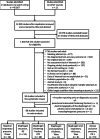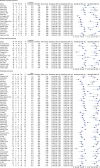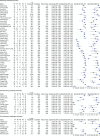Accuracy of respiratory muscle assessments to predict weaning outcomes: a systematic review and comparative meta-analysis
- PMID: 38454487
- PMCID: PMC10919035
- DOI: 10.1186/s13054-024-04823-4
Accuracy of respiratory muscle assessments to predict weaning outcomes: a systematic review and comparative meta-analysis
Abstract
Background: Several bedside assessments are used to evaluate respiratory muscle function and to predict weaning from mechanical ventilation in patients on the intensive care unit. It remains unclear which assessments perform best in predicting weaning success. The primary aim of this systematic review and meta-analysis was to summarize and compare the accuracy of the following assessments to predict weaning success: maximal inspiratory (PImax) and expiratory pressures, diaphragm thickening fraction and excursion (DTF and DE), end-expiratory (Tdiee) and end-inspiratory (Tdiei) diaphragm thickness, airway occlusion pressure (P0.1), electrical activity of respiratory muscles, and volitional and non-volitional assessments of transdiaphragmatic and airway opening pressures.
Methods: Medline (via Pubmed), EMBASE, Web of Science, Cochrane Library and CINAHL were comprehensively searched from inception to 04/05/2023. Studies including adult mechanically ventilated patients reporting data on predictive accuracy were included. Hierarchical summary receiver operating characteristic (HSROC) models were used to estimate the SROC curves of each assessment method. Meta-regression was used to compare SROC curves. Sensitivity analyses were conducted by excluding studies with high risk of bias, as assessed with QUADAS-2. Direct comparisons were performed using studies comparing each pair of assessments within the same sample of patients.
Results: Ninety-four studies were identified of which 88 studies (n = 6296) reporting on either PImax, DTF, DE, Tdiee, Tdiei and P0.1 were included in the meta-analyses. The sensitivity to predict weaning success was 63% (95% CI 47-77%) for PImax, 75% (95% CI 67-82%) for DE, 77% (95% CI 61-87%) for DTF, 74% (95% CI 40-93%) for P0.1, 69% (95% CI 13-97%) for Tdiei, 37% (95% CI 13-70%) for Tdiee, at fixed 80% specificity. Accuracy of DE and DTF to predict weaning success was significantly higher when compared to PImax (p = 0.04 and p < 0.01, respectively). Sensitivity and direct comparisons analyses showed that the accuracy of DTF to predict weaning success was significantly higher when compared to DE (p < 0.01).
Conclusions: DTF and DE are superior to PImax and DTF seems to have the highest accuracy among all included respiratory muscle assessments for predicting weaning success. Further studies aiming at identifying the optimal threshold of DTF to predict weaning success are warranted.
Trial registration: PROSPERO CRD42020209295, October 15, 2020.
Keywords: Intensive care unit; Mechanical ventilator weaning; Predictive accuracy; Respiratory muscle assessments.
© 2024. The Author(s).
Conflict of interest statement
The authors declare that they have no competing interests.
Figures




References
-
- Demoule A, Jung B, Prodanovic H, Molinari N, Chanques G, Coirault C, et al. Diaphragm dysfunction on admission to the intensive care unit. Prevalence, risk factors, and prognostic impact-a prospective study. Am J Respir Crit Care Med. 2013;188(2):213–219. doi: 10.1164/rccm.201209-1668OC. - DOI - PubMed
-
- Dres M, Dube BP, Mayaux J, Delemazure J, Reuter D, Brochard L, et al. Coexistence and impact of limb muscle and diaphragm weakness at time of liberation from mechanical ventilation in medical intensive care unit patients. Am J Respir Crit Care Med. 2017;195(1):57–66. doi: 10.1164/rccm.201602-0367OC. - DOI - PubMed
Publication types
MeSH terms
Grants and funding
LinkOut - more resources
Full Text Sources

